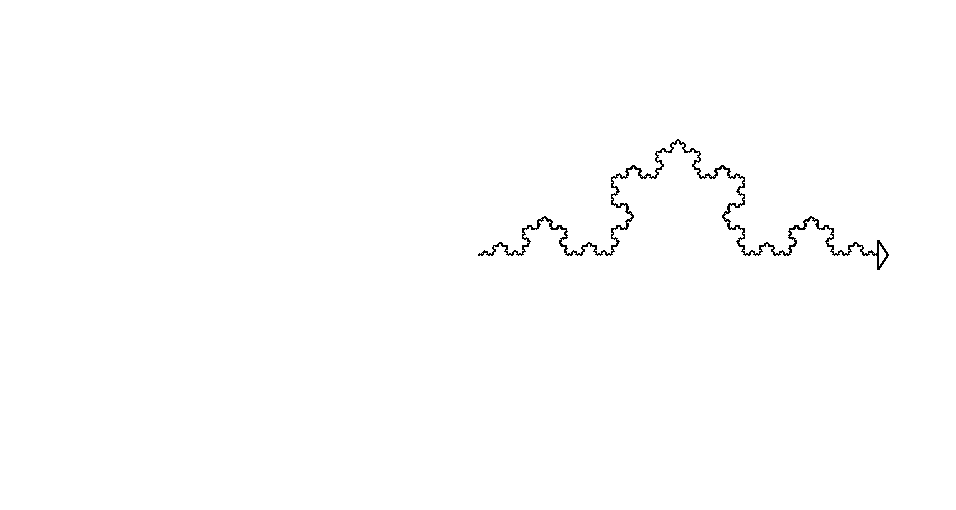A prototype to test a few ideas.
An L-system or Lindenmyer-system is a
parallel rewriting system and a type of formal grammar. An L-system consists of an alphabet of symbols that can be used to make strings, a collection of production rules that expand each symbol into some larger string of symbols, an initial "axiom" string from which to begin construction, and a mechanism for translating the generated strings into geometric structures. L-systems were introduced and developed in 1968 by Aristid Lindenmayer, a Hungarian theoretical biologist and botanist at the University of Utrecht.
Inspired by the Fractal Tree coding challenge, we want to recreate that image with Rust. Furthermore we want to explore ways of working with L-systems in such a way that is is easy to change a visualization methods.
The initial implementation rendered the famous Koch curve from the following L-system.
start: F
F -> F-F++F-F
This was implemented by hand with
#[derive(Debug, PartialEq, Eq, Hash, Clone, Copy)]
enum Variable {
F,
Plus,
Minus,
}
type Word = Vec<Variable>;
type Rules = HashMap<Variable, Vec<Variable>>;
fn main() {
let mut rules: Rules = HashMap::new();
rules.insert(
Variable::F,
vec![
Variable::F,
Variable::Minus,
Variable::F,
Variable::Plus,
Variable::Plus,
Variable::F,
Variable::Minus,
Variable::F,
],
);
let mut word = vec![
Variable::F,
];
}The heart of the L-system is the apply functions which takes a words and replaces all the occurrences of a variable with their substitution, leaving the original variable when there is no substitution.
fn apply(rules: &Rules, word: Word) -> Word {
word
.into_iter()
.fold(Vec::new(), |mut acc, variable|{
match rules.get(&variable) {
Some(substitution) => {
for var in substitution {
acc.push(var.clone());
}
}
None => {
acc.push(variable)
}
}
acc
})
}The image is drawn on screen with the turtle crate. A draw function accepts a word to draw and a turtle that will do the drawing.
fn draw<C>(word: &Word, turtle: &mut Turtle, c: C)
where
C: Into<Config>,
{
let config: Config = c.into();
for variable in word {
match variable {
Variable::F => {
turtle.forward(config.step);
}
Variable::Minus => {
turtle.left(config.angle);
}
Variable::Plus => {
turtle.right(config.angle);
}
}
}
}
struct Config {
step: f64,
angle: f64,
}
impl Default for Config {
fn default() -> Self {
Self {
step: 100.0,
angle: 60.0,
}
}
}The implementation was straight forward with with each part of L-systems, i.e. definition, generation and visualization, having a clear counter part in code.
The visualization is tightly bound to the definition of the L-systems. I could not change the definition of the L-system without needing to change the visualization.
The implementation does not does not support all features of turtle graphics. Most notable it the lack to push and pop states from the stack.
I created an Renderer trait with a prototype::render::crab::Crab and a prototype::render::string::Collector implementation.
pub trait Renderer {
fn forward(&mut self);
fn left(&mut self);
fn right(&mut self);
}The Collector shows the generated string
F-F++F-F-F-F++F-F++F-F++F-F-F-F++F-F-F-F++F-F-F-F++F-F++F-F++F-F-F-F++F-F++F-F++F-F-F-F++F-F++F-F++F-F-F-F++F-F-F-F++F-F-F-F++F-F++F-F++F-F-F-F++F-F-F-F++F-F-F-F++F-F++F-F++F-F-F-F++F-F-F-F++F-F-F-F++F-F++F-F++F-F-F-F++F-F++F-F++F-F-F-F++F-F++F-F++F-F-F-F++F-F-F-F++F-F-F-F++F-F++F-F++F-F-F-F++F-F++F-F++F-F-F-F++F-F++F-F++F-F-F-F++F-F-F-F++F-F-F-F++F-F++F-F++F-F-F-F++F-F++F-F++F-F-F-F++F-F++F-F++F-F-F-F++F-F-F-F++F-F-F-F++F-F++F-F++F-F-F-F++F-F-F-F++F-F-F-F++F-F++F-F++F-F-F-F++F-F-F-F++F-F-F-F++F-F++F-F++F-F-F-F++F-F++F-F++F-F-F-F++F-F++F-F++F-F-F-F++F-F-F-F++F-F-F-F++F-F++F-F++F-F-F-F++F-F
This allows for swapping the rendering implementation more easily.
This is very much geared to a turtlecrab-graphics rendition.
Should we have have more general render contact? The book extends crab-graphics to three dimensions. In what direction do we want to go?
The crab can now push it's state on a [ and pop to that state on ]. The Renderer trait is extended with push and pop methods.
For a 3 dimensional crab we could provide an Renderer3d that inherits all the functions of Renderer and add some more.
In a push towards a dynamic representation of rules we swapped the enum-based implementation to a symbol based implementation.
#[derive(Debug, PartialEq, Eq, Hash, Clone, Copy)]
struct Variable {
symbol: char,
}It allows for a dynamic definition of L-system rules.
We have lost the compile time check.
With the crab-graphics interpretation we already lost the compile time check because we have to ignore the symbols other then F+-[], so there is little lost with this design.
We are working on a struct based parser combinator framework. The core abstraction issuecomment
pub trait Parser<'a, T> {
fn parse(&self, input: &'a str) -> Result<(T, &'a str), ParseError>;
}
#[derive(Debug, PartialEq)]
pub enum ParseError {
IO,
ExpectingCharacter(char),
ExpectingPredicate,
EndOfInput,
GenericError,
}Each building block, or combinator implements the Parser trait. For example a at_least parses at least n of the things that parser parses.
pub struct AtLeast<'a, T, P> where T: 'a, P: Parser<'a, T> + Sized {
n: u8,
parser: P,
phantom: PhantomData<&'a T>,
}
impl<'a, T, P> AtLeast<'a, T, P> where T: 'a, P: Parser<'a, T> + Sized {
pub fn new(n: u8, parser: P) -> Self {
AtLeast { n, parser, phantom: PhantomData }
}
}
pub fn at_least<'a, T>(n: u8, parser: impl Parser<'a, T>) -> impl Parser<'a, Vec<T>> {
AtLeast::new(n, parser)
}
impl<'a, T, P> Parser<'a, Vec<T>> for AtLeast<'a, T, P> where P: Parser<'a, T> + Sized {
fn parse(&self, input: &'a str) -> Result<(Vec<T>, &'a str), ParseError> {
let mut result = vec![];
let mut source = input;
let mut count = self.n;
while count > 0 {
let attempt = self.parser.parse(source);
match attempt {
Ok((value, rest)) => {
result.push(value);
source = rest;
}
Err(e) => {
return Err(e);
}
}
count -= 1;
}
loop {
let attempt = self.parser.parse(source);
match attempt {
Ok((value, rest)) => {
result.push(value);
source = rest;
}
Err(_) => {
break;
}
}
}
Ok((result, source))
}
}Besides lifetime issues and the occasional PhantomData, the struct based parser is simple to work with. The process is largely "mechanize-able", i.e. for a type of parser like character, any, map
- Create a struct containing the necessary fields,
- Implement
Parserfor struct.
All of this is "standard" Rust.
At times it feels tedious to spell everything out.
I feel that Parser API could be a bit more lean. It seems very heavy on the generics side.

